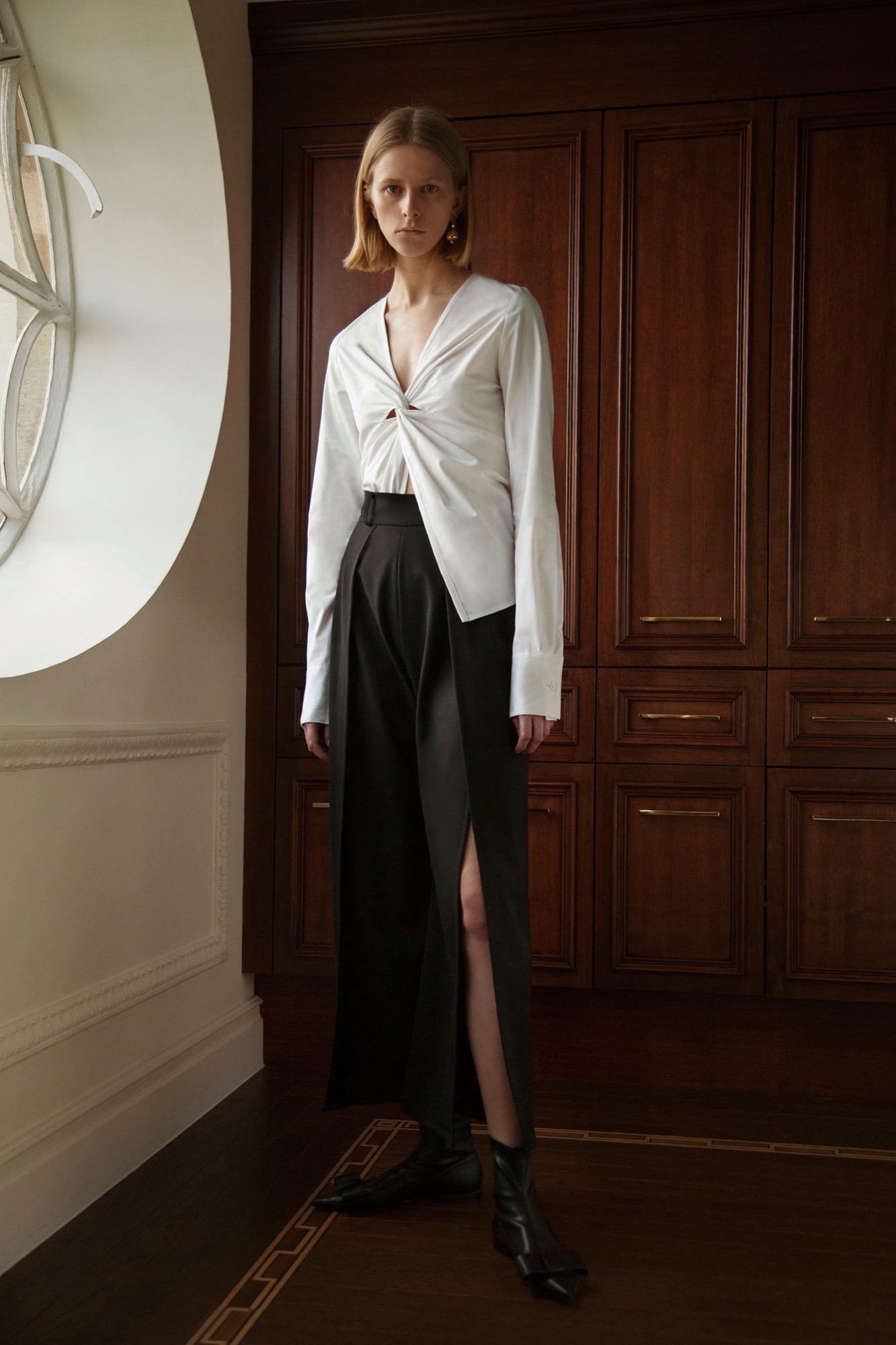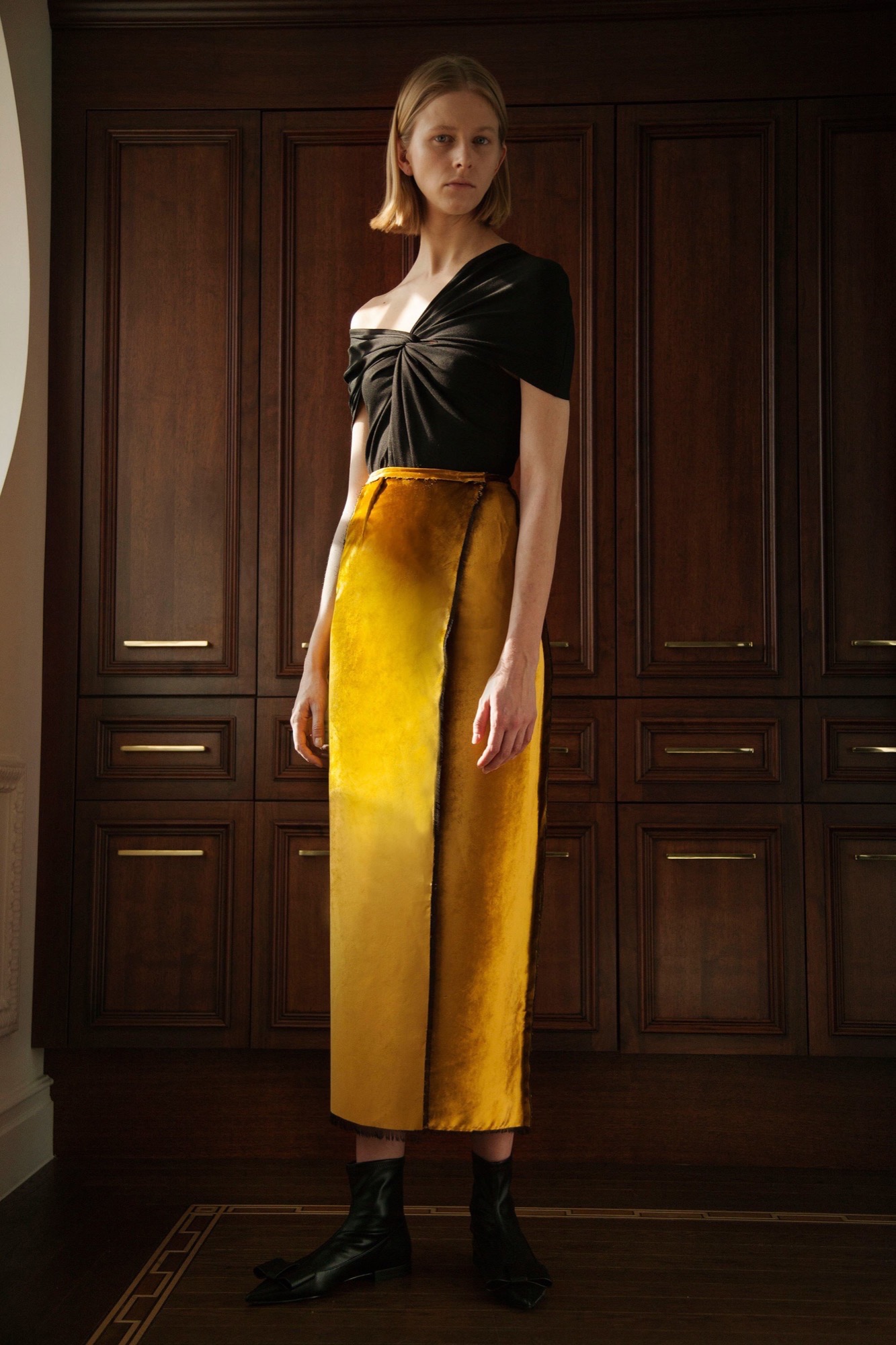Besides being a talented designer whose eye for the avant-garde has earned him A-list clients such as Jennifer Aniston, Jada Pinkett-Smith and Coco Rocha, Alberta-born Sid Neigum is just plain smart. The 29-year-old had been studying science in university when he decided to shift his focus to cutting and sewing. The label has, in the mere six years since its inception, established a signature sculptural aesthetic that draws on the cerebral — the golden ratio, a mathematical ideal geometry found in history’s most eye-pleasing examples of art, design, even nature. And this fall, as his surprisingly different — and more feminine — collection enters Net-a-Porter and more luxury retailers worldwide, this millennial’s greatest attribute is clear: the ability to listen and learn.
Neigum was born in the small oil town of Drayton Valley (population, 6,000-ish), just outside of Edmonton. While other kids were sticks up in hockey, Neigum spent his youth playing in punk and metal bands, developing a keen fascination for musician dressing (his uniform is still all-black jeans and T-shirts, of his own design). His grandmother was a seamstress and her influence rubbed off. “Without making a pattern, she would just grab the measuring tape and whip up a dress for my sister,” Neigum remembers. “I always found it interesting that she could create something from nothing in an hour.”
It took Neigum’s parents several years to accept the fact that he wanted to follow in her footsteps rather than pursue a career as a doctor, a goal he aspired to after working at a hospital.
He first attended MC College in Edmonton before venturing on to New York’s Fashion Institute of Technology. His next position was serving as an intern with designer Yigal Azrouel. “I was at the bottom of the food chain,” Neigum remarks. “But while I was fetching coffee, I could see how the structure of the business was working, like how many seamstresses and designers they had.”
He gleaned all he could from being on the inside, and today Neigum makes almost all of his samples and smaller units of production in his Toronto studio, then outsources anything over 50 or 100 units to contractors, in much the same way he’d learned from his mentors.
Despite his being a quick study, the first runway show at Toronto Fashion Week in 2011 went over badly. The collection was naïve, Neigum recalls, and a big part of the focus was on androgyny, a concept he’s since abandoned because “most department stores don’t have unisex sections,” he notes. An unflattering review by Sarah Nicole Prickett at the Toronto Standard declared that it was “smart of Neigum to combine historical Japanese influences — although I’m not sure how well he understood them — with the contemporary ones.”
But rather than interpret the criticism as insult, Neigum heeded it as advice. “I really took it to heart, like, okay, good point.” He spent the next while honing in on his vision. The result was collection after womenswear collection using the golden ratio as the golden rule. Architects like Zaha Hadid and Rem Koolhaas could be found on the young designer’s mood boards. (As an example, one might detect a trace of Frank Gehry’s Deconstructionist Los Angeles Walt Disney Concert Hall in Neigum’s 2015 white three-dimensional scarf-cum-halter top.) In 2012 Neigum received Toronto Fashion Incubator’s New Labels Award. More accolades followed. In 2015 the line was picked up by The Room at The Bay and, shortly thereafter, by Simons.
The turning point toward broader recognition happened last year when Neigum was granted the DHL Exported Program in London, which meant that he would be able to show at London Fashion Week for two seasons at no cost. It was there that Maya Singer of Vogue.com took notice, calling Neigum “one to watch” in a positive review of his FW’16 collection. Soon Neigum found himself meeting with buyers all over the world. They loved his clothing, but they demanded changes.“
A lot of the feedback was from the Middle East, because I’m so used to designing for the climate that I’m in,” explains Neigum, who struggled to justify the heavier fabrics he had been using to articulate his constructions, when buyers were sitting in 45-degree weather. “I think a lot of Canadian designers’ spring collections are too heavy, and even their fall collections probably, because our weather is so much colder than average.”
Neigum started researching temperatures for various cities that corresponded to in-store dates and adjusted the fabrics for his fall 2017 collection accordingly. Comprised of lighter-weight velvets and silky pleats, the sensibility is noticeably softer — and more wearable. Since the presentation, he’s booked four retailers in the Middle East, Joyce in Hong Kong, Boutique 1 in London and, most significant, Net-a-Porter, raising his overall production by 1,208 percent virtually overnight.
At first glance, one might worry Neigum is abandoning his hard-won vision, but like all of his clothes, one need only look more closely to realize that the DNA is still there.
“People were, like, ‘It’s so different than past collections.’ I had to remind them that it’s the same pattern as this [other] collection, but with a totally different fabric and a manipulation detail like a knot,” Neigum explains. “The same geometry and patterns used with super-fluid fabric changes things so much.” Neigum rather enjoyed slashing apart all of his old patterns, then adding a twist or a tie in order to put them back together again to create something new.
Now that women from New York to Paris to Hong Kong will be able to order one of his pieces at the click of a button, what will Neigum learn how to do next? Well, he already has a side hustle, customizing the interiors of high-performance cars like Porsches and McLarens with Pfaff. He’d like to get back to playing music if he can spare the time, particularly on the 150-year-old wooden piano that sits in the downtown condo he shares with his girlfriend, Chloé Gordon, one of the designers for fellow Canadian fashion label Beaufille. “It sounds cheesy and lame, but I hope to be doing the same thing, just what I love.”
On the contrary, the most evolved among us think just like this.
By Carlene Higgins – *This article originally appeared in INSIGHT: The Art of Living | Fall 2017







